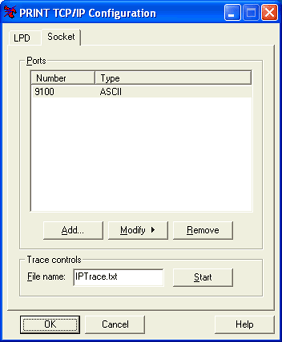
Use this tab to set up and maintain TCP/IP socket ports. You can access this tab from the TCP/IP Configuration utility.
To view this tab, you must have the appropriate user access rights.
Click an option you want to learn more about.

Lists defined TCP/IP ports.
Add button
Adds a TCP/IP port and defines its properties.
Modify button
Modifies the selected TCP/IP port. Select Properties to display the Port Properties dialog box where you can modify the port number and document attributes. Select Conversions to display the Input Conversion Utility where you can modify the type of files being sent using the Format tab and the Options tab.
Remove button
Deletes the selected TCP/IP port.
Lists controls for capturing a trace of socket data to be used for diagnostic purposes.
File name
Specifies the name of the trace file. The default file name is IPTrace.txt. The file will be saved in the Trace folder.
Start/Stop button
Starts and stops the trace. After you start the trace, the button label changes to Stop. The trace continues to record until you click Stop.
Performance Tuning: Leaving the socket trace running can greatly degrade performance. The socket trace is intended as a diagnostic tool only and must not be used in production settings. If you close the TCP/IP Configuration utility while the trace is running, a message will ask you if you want to stop the trace.